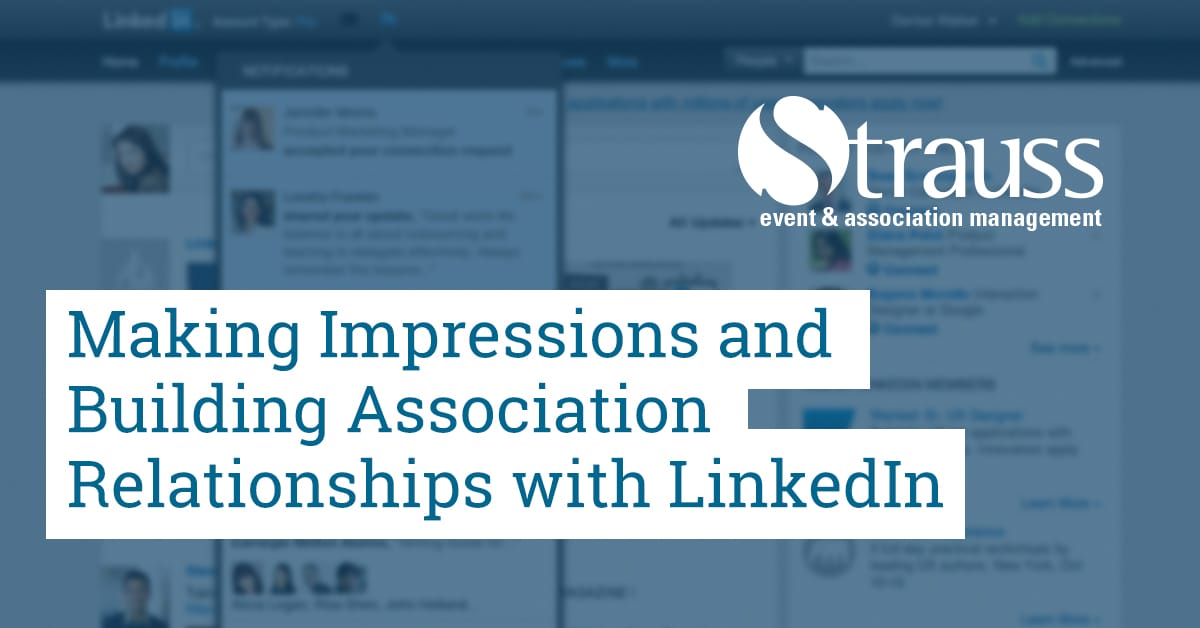As an association leader, you are interconnected with other leader and members in your industry. LinkedIn is a great way to capitalize on those connections and further build your professional relationships. This might be surprising, but LinkedIn has been around longer than Facebook, and is widely considered the “number one professional social networking site.”
LinkedIn has over 675 million registered members, and 40% of those users access the platform daily. However, LinkedIn’s users typically spend an average of only 17 minutes per month on the platform. This means that users are not spending a ton of time looking through your profile, so it is important to make a strong impression with your LinkedIn. Having an impactful profile will help you continue to represent your association in a positive light and help grow its online profile—and expand your own network as well.
Encouraging other members of your association and board to participate on LinkedIn also breeds a sense of camaraderie and boosts membership engagement. My colleague’s article offers some great insight on Capturing Millennials Using your Association’s Social Media. For more ways to increase member engagement, refer to this interview with an association leader.
Social Selling Index
The Social Selling Index (SSI) is a tool on LinkedIn that measures how effective you are at establishing your professional brand, finding the right people, engaging with insights, and building professional relationships. The index is updated daily based on your profile.
There are four categories that make up your SSI. Here are some ways to improve your SSI and make an impression on whomever views your profile:
Establish Your Professional Brand:
The first step is gearing your profile for success. Think about who is going to view your profile and what information they may want to find out about you. Try to complete your profile with
- a clear/non-blurry professional profile photo of yourself, by yourself.
- a headline—this doesn’t have to be your job title. It should be short and eye-catching and capture who you are and what you do in a few words.
- an updated job title that is current or most recent. You can add relevant work and volunteer experience as well.
- a short but rich “About” section that briefly describes who you are and what you do. You should use this section to expand on your headline and give the details that show anyone who views your profile that you live up to the label you’ve given yourself.
Find the Right People:
Search for people you know. They don’t have to be close friends or family, just people you’ve worked/collaborated with. Even if you haven’t worked with them much, you likely have experience working with lots of different people, so connect with them.
- Pro tip: Some people’s profiles ask you to attach a message to the connection requestion. Briefly remind them where they know you from or how you’ve worked together and why you are connecting with them (e.g. I am working on building my network and I’d like to connect with you. Thanks!)
- If you don’t have a lot of connections or don’t know where to begin, start by searching for your coworkers—you’ll probably find more connections through them as well.
Engage with Insights:
Post, share, and interact with content. You don’t have to post 10 articles a day, or even one a day. If your association, company, or AMC posts articles to a blog or website regularly, that’s a great place to start. However, you don’t need to restrict yourself to posting/sharing articles that only pertain to your profession. A great way to find articles that interest you is to follow organizations that interest you.
- Articles you might find elsewhere are sometimes worth sharing. One curious night last week, I found an article on The History of Lawns. Why not share to LinkedIn?
- Networking tip: Scroll through your feed and like/comment on articles or posts shared by your connections.
Build Relationships
Having a larger network helps to find new prospective clients/association members/etc. Follow up with connections who might be potential clients, members, or other professionals that could benefit you or your organization.
- When you connect with your colleagues, use TeamLink. When connecting with other people whose profiles indicate they work at your organization, LinkedIn will ask if you are team members and what your professional relationship is. Fill this out to further complete your profile.
- Periodically check in with connections. Comment on their posts. Ask if there is anything you can do for them—any answers to questions they might have or solutions to challenges they are facing. Sometimes people will put out an open call to their network asking if they need help with certain tasks or problems. Also, just ask how they’re doing. It’s nice to be checked in on once in a while.
Conclusion
Check your SSI weekly as you continue to follow these guidelines. It’s important to allow yourself to be yourself on social media. The interconnectivity that LinkedIn provides will further boost your network and possibly puts you in touch with colleagues that can help you take your career to the next level within your association. Sharing who you are is also a great way to build relationships and become well connected within your association and your industry.
For more on coming together to improve one another, read my colleague’s article The Pandemic Presents Opportunities for Partnership.

